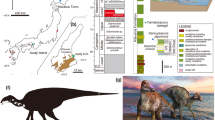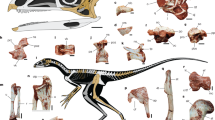Abstract
Furculae have been identified in many dinosaurs and are synapomorphic in some clades (e.g., dromaeosaurids). All coelophysid dinosaurs exceptCoelophysis bauri have been shown to possess furculae. To date, the oldest well-documented furculae have been those of the Early Jurassic coelophysids,Coelophysis kayentakatae andCoelophysis rhodesiensis. The confirmation of furculae in Apachean-agedC. bauri further documents appearance of these elements in the Late Triassic and shows that furculae are synapomorphic in the Coelophysidae. A total of five furculae have been found in New Mexico Museum of Natural History’s (NMMNH) Ghost Ranch, New Mexico Whitaker Quarry block C-8-82. We describe three furculae in articulated juvenile skeletons; two that are missing fragments but are nearly complete, and one apparently complete, a small fragment of a furcula associated with an adultC. bauri, and one complete but isolated furcula. We access the morphology and allometry of the scapulocoracoid and furcula and show that they grow, at least in juveniles, in isometry with the humerus. The furcula ofC. bauri has a widely opened U shape that subtends an angle of ∼ 120°. All the furculae have groove-like epicleidial facets at the distal ends of the rami and some possess a small centrally located hypocleideal process. We reconstruct the complete Shoulder girdle ofC. bauri with proper spacing and angles between the elements and find that the coracoids are very close together under the center of the furcula.
Kurzfassung
Furculae wurden in vielen Dinosauriern gefunden und sind in einigen Gruppen synapomorph (z.B. Dromaeosauridae). Furculae wurden in allen Coelophysiden nachgewiesen, mit der Ausnahme vonCoelophysis bauri. Die ältesten gut dokumentierten Furculae bei Theropoden waren bisher jene der unterjurassischen CoelophysidenCoelophysis kayentakatae undCoelophysis rhodesiensis. Die Bestätigung der Präsenz von Furculae inCoelophysis bauri, mit einem Apachium-Alter, beweist weiter den Ursprung dieses Elementes in der späten Trias und zeigt, dass Furculae für Coelophysiden synapomorph sind. Insgesamt wurden fünf Furculae in dem Block C-8-82 aus dem Ghost Ranch, New York Whitaker Quarry im New Mexico Museum of Natural History (NMMNH) gefunden. Wir beschreiben drei Furculae von artikulierten, juvenilen Exemplaren, von denen zwei fast vollständig und eine scheinbar vollständig ist, eine fragmentarische Furcula, die mit einem adulten Exemplar vonCoelophysis bauri assoziiert ist und eine vollständige, aber isolierte Furcula. Wir analysieren die Morphologie und Allometrie des Scapulocoracoids und der Furcula und zeigen, dass sie, zumindest in Jungtieren, in Bezug auf den Humerus isometrisch wachsen. Die Furcula vonC. bauri ist breit U-förmig, mit einem Winkel von ungefähr 120° zwischen den Ästen. Alle Furculae haben kleine, grubenförmige Epicleithral-Facetten an den distalen Enden der Äste und einige weisen kleine, zentral gelegene Hypocleithral-Fortsätze auf. Wir rekonstruieren den gesamten Schultergürtel vonC. bauri, mit den exakten Abständen und Winkeln zwischen den Elementen und finden, dass die Coracoide unter der Spitze der Furcula sehr eng zusammen lagen.
Similar content being viewed by others
References
Bristowe, A. &Raath, M.A. 2004. A juvenile coelophysoid skull from the Early Jurassic of Zimbabwe, and the synonmy ofCoelophysis andSyntarsus. — Palaentologia Africana40: 31–41.
Bryant, H.N. &Russell, A.P. 1993. The occurrence of clavicles within Dinosauria: implications for the homology of the avian furcula and the Utility of negative evidence. — Journal of Vertebrate Paleontology13 (2): 171–184.
Camp, C.L. 1936. A new type of small bipedal dinosaur from the Navajo Sandstone of Arizona. — University of California Publications in Geological Sciences24: 39–56.
Carrano, M.T.;Hutchinson, J.R. &Sampson, S.D. 2005. New Information onSegisaurus halli, a small theropod from the Early Jurassic of Arizona. — Journal of Vertebrate Paleontology25 (4): 835–849.
Chure, DJ. &Madsen, JJ.H. 1996. On the presence of furculae in some non-maniraptoran theropods. — Journal of Vertebrate Paleontology16 (3): 573–577.
Colbert, E.H. 1989. The Triassic dinosaurCoelophysis. — Museum of Northern Arizona Bulletin57: 1–160.
Downs, A. 2000.Coelophysis bauri andSyntarsus rhodesiensis compared, with comments on the preparation and preservation of fossils from the Ghost RanchCoelophysis Quarry. — New Mexico Museum of Natural History and Science Bulletin17: 33–37.
Glantz, S.A. &Slinker, B.k. 2001. Primer of Applied Regression and Analysis of Variance. — 949 p., New York (McGraw-Hill).
Ostrom, J.H. 1976.Archaeopteryx and the origin of birds. — Biological Journal of the Linnean Society8 (2): 91–182.
Paul, G.S. 2002. Dinosaurs of the Air. — 460 p., Baltimore (Johns Hopkins University Press).
Raath, M.A. 1969. A new coelurosaurian dinosaur from the Forest Sandstone of Rhodesia. — Arnoldia4: 1–25.
Rauhut, O.W.M. 2003. The interrelationships and evolution of basal theropod dinosaurs.— Special Papers in Palaeontology69: 1–213.
Reiss, M.J. 1989. The Allometry of Growth and Reproduction. — 182 p., Cambridge (Cambridge University Press).
Senter, P. 2006. Scapular orientation in theropods and basal birds, and the origin of flapping flight. — Acta Palaeontologica Polonica51 (2): 305–313.
Tykoski, R.S.;Forster, CA.;Rowe, T.;Sampson, S.D. &Munyikwa, D. 2002. A furcula in the coelophysid theropodSyntarsus. — Journal of Vertebrate Paleontology22 (3): 728–733.
Yates, A.M. &Vasconcelos, C.C. 2005. Furcula-like clavicles in the prosauropod dinosaurMassospondylus. — Journal of Vertebrate Paleontology25 (2): 466–468.
Author information
Authors and Affiliations
Corresponding author
Rights and permissions
About this article
Cite this article
Rinehart, L.F., Lucas, S.G. & Hunt, A.P. Furculae in the Late Triassic theropod dinosaurCoelophysis bauri . Paläontol Z 81, 174–180 (2007). https://doi.org/10.1007/BF02988391
Received:
Accepted:
Issue Date:
DOI: https://doi.org/10.1007/BF02988391




